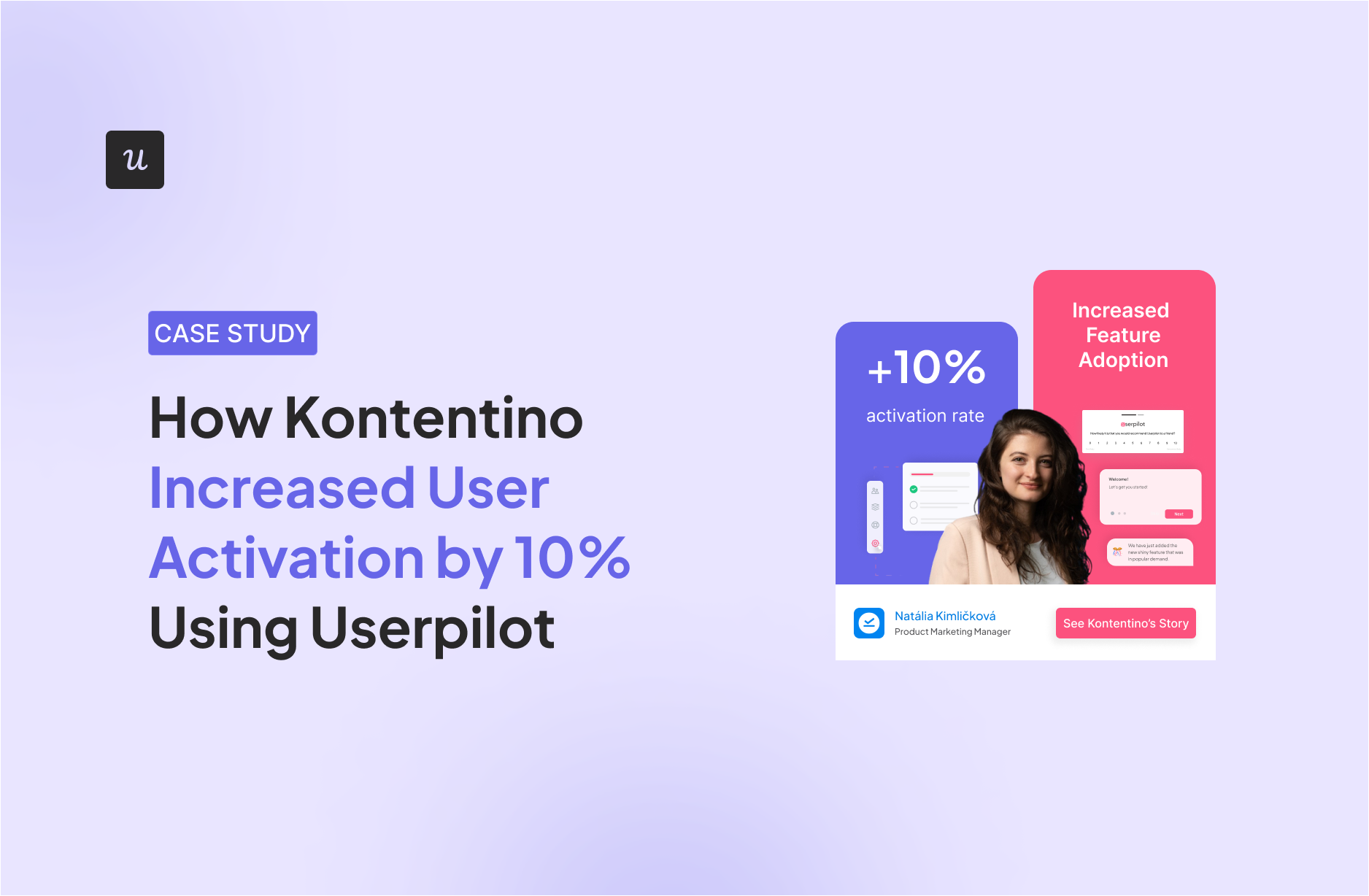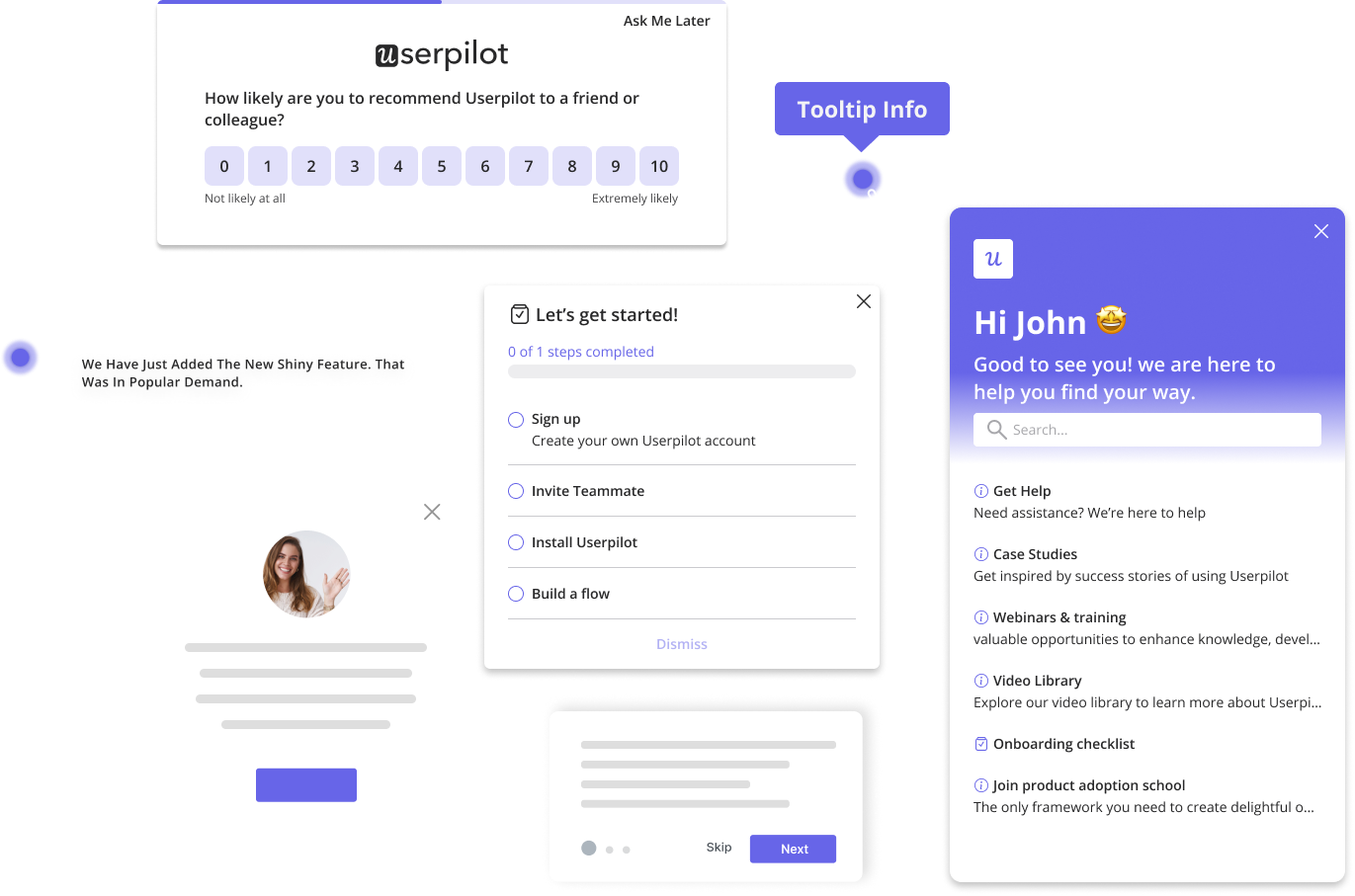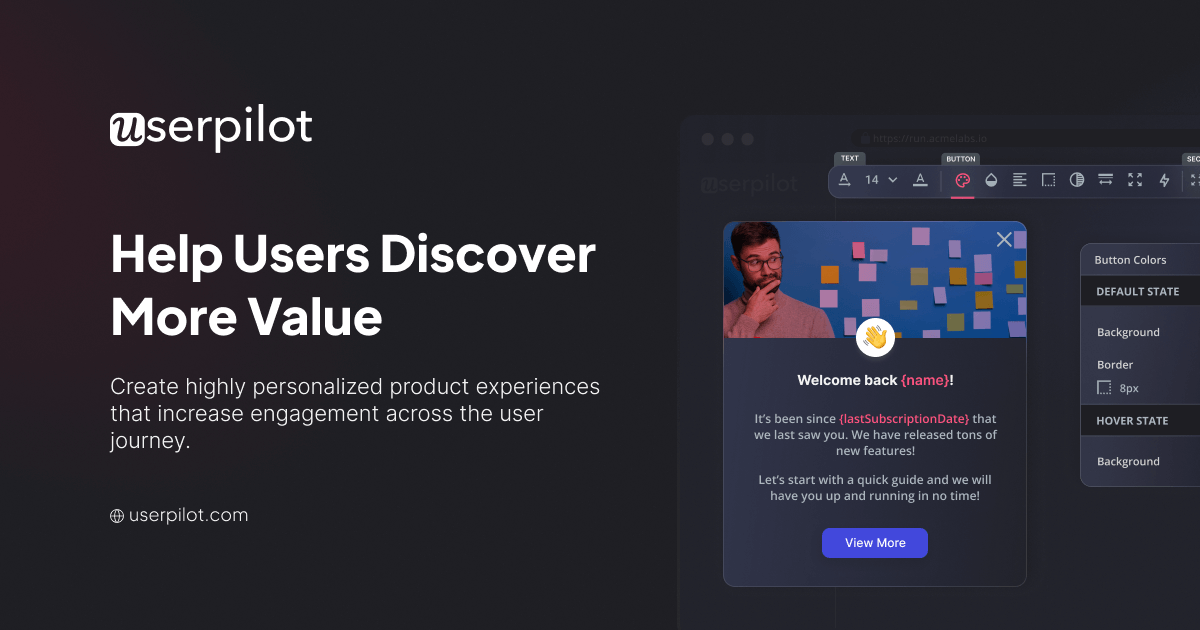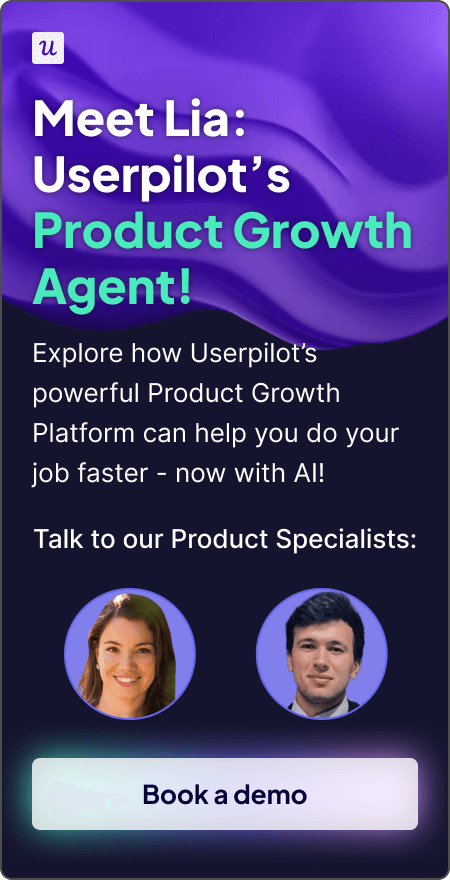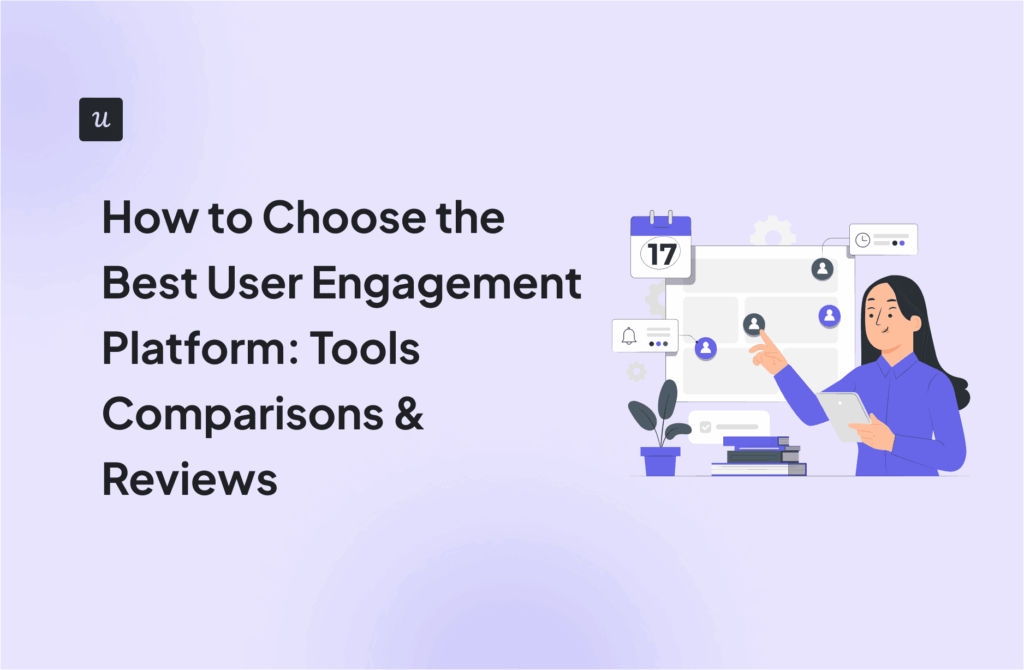
User Engagement Strategy: How to Activate, Retain, and Expand Customers Across Every Stage
A user engagement strategy isn’t just a buzzword. It’s a deliberate plan that helps users interact more deeply with your product, stay satisfied, and become loyal advocates.
After years of growing SaaS products, I’ve learned one thing for certain: sustainable growth doesn’t come from a scattered approach. It comes from building a system where every user touchpoint adds value and creates a natural pull to stay.
That’s why in this article, I’ll share the framework I use to drive product engagement across three pillars: Activation, Retention, and Expansion.
We’ll explore practical tactics for each stage and see how tools like Userpilot can help you implement these strategies effectively.
Try Userpilot Now
See Why 1,000+ Teams Choose Userpilot
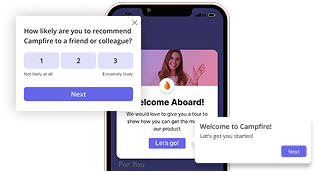
What is user engagement?
User engagement is a measure of the depth and quality of customer interactions with your product.
It goes beyond surface-level metrics like logins and clicks to show whether users are experiencing the product’s value, seeing progress toward their goals, and integrating your product into their daily workflow.
An engaged user is someone who actively interacts with your product and grows alongside it. They eagerly explore new features, achieve recurring success, and often advocate for your product within their team or network.
The user journey within any SaaS product isn’t a simple, linear path. It’s a dynamic, continuous cycle of growing value and deepening connection. This journey typically falls into three essential, interconnected stages, each demanding specific attention and strategy:
- Activation: The critical first step focused on helping new users quickly discover your product’s core value, reach their first “Aha! Moment,” and adopt your key features.
- Retention: The ongoing effort to ensure users keep returning by consistently delivering evolving value that makes your product indispensable.
- Expansion: The growth phase where you nurture relationships, help users unlock advanced value, and transform them into passionate advocates and champions.
Adopting this approach ensures that, regardless of where your users are in their journey, you consistently meet their needs and guide them toward deeper engagement and long-term loyalty.
What is a user engagement strategy?
A user engagement strategy is a holistic framework that guides how you attract, activate, retain, and expand your users.
It brings structure to what might otherwise feel like scattered efforts. Instead of simply reacting to churn reports, pushing one-off onboarding flows, or sending sporadic in-app messages, a well-documented engagement strategy helps you deliver consistent, meaningful experiences that drive both growth and loyalty.
Other benefits I’ve seen include:
- Cross-team alignment: Everyone, from product to marketing to success, operates with the same understanding of what engagement means and how to measure it.
- More predictable outcomes: When engagement activities are intentional and repeatable, it becomes easier to forecast impact and replicate wins.
- Data-driven iteration: A solid strategy means you can more easily track what’s working, spot weak points in the user journey, and continuously improve the customer experience.
- Stronger customer relationships: Users feel guided, understood, and supported, not just sold to.
- Higher ROI from product investments: Each feature or campaign contributes directly to long-term engagement rather than short-term spikes.
In the sections below, I’ll cover proven engagement strategies for the key stages of the user journey. We’ll start with practical approaches for driving new user engagement, then discuss tactics for nurturing ongoing engagement among existing users, and end with strategies to drive account expansion and advocacy.
User engagement strategies to turn new users into active users
The activation stage is arguably the most critical phase in the entire user lifecycle. This is the point where a new user first experiences the core value of your product. If you don’t get this right, you risk losing them before they ever grasp what your product can truly do, leading to high churn and wasted acquisition efforts.
When researching for our Product Metrics Benchmark Report, we found that the average activation rate across SaaS companies is 37.5%. This aligns with other industry findings, such as Lenny’s research, which places the average around 34%.
In simple terms, only about one in three new users reach the moment where they experience a product’s core value. The good news is that this can be improved. Our internal data shows that teams with a strong go-to-market motion and a deliberate new customer engagement strategy can raise activation significantly.
Here are four best practices we follow at Userpilot to help new users become active, engaged customers:
Personalize the new user onboarding process
Users arrive with diverse needs, varied roles, and specific goals, so their initial journey must reflect that individuality.
At Userpilot, we begin by using welcome surveys to capture key user data such as job role, goals, industry, and company size. Then we deliver branched onboarding flows tailored to those needs.
For example, a product manager who indicates that their goal is to “improve user retention” might see onboarding screens that highlight in-app engagement features like tooltips and checklists. Meanwhile, a growth marketer focused on “boosting product adoption” could be guided toward analytics dashboards or A/B testing tools instead.
Kontentino used the same principle to improve activation. Their team leveraged Userpilot’s segmentation capabilities to segment users early by role and objectives, then built onboarding flows that spoke directly to each segment’s unique context.
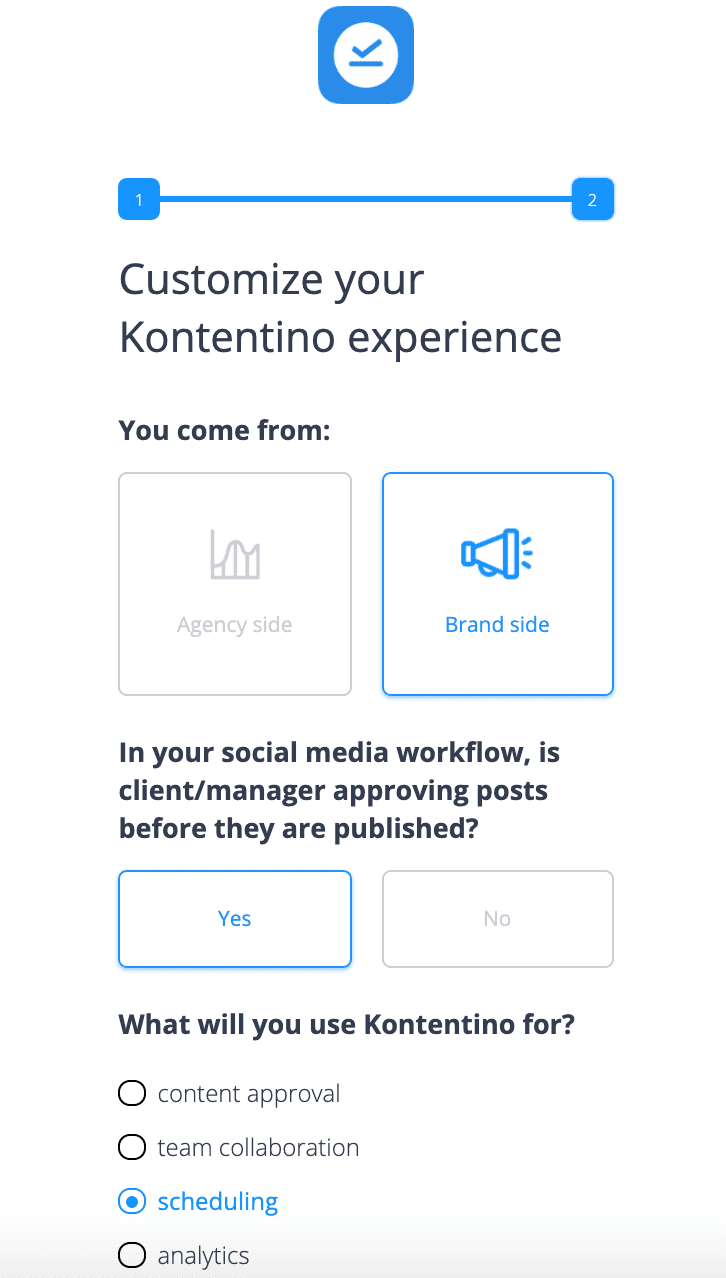
The result? 10% boost in activation within 30 days of implementing Userpilot.
“Our feature adoption increased after successfully creating and optimizing new-user onboarding flows with Userpilot,” said Natália Kimličková, former Product Marketing Manager at Kontentino.
Use interactive walkthroughs to guide users through the product
You’ve gathered customer data and are ready to guide them through your product. But what tool should you use for this?
Many companies rely on static product tours. These can be helpful when embedded on a website to showcase features to potential customers, but they rarely work for onboarding new users inside the app.
Why? Because static tours are passive. Users often skip through them without taking any real action, which means they finish the tour without actually learning how to use the product or seeing its value.
Interactive walkthroughs, on the other hand, are designed around the principle of learning by doing. They introduce one feature at a time, guiding users step by step as they complete real actions. For example, while a static product tour might simply show users how an analytics dashboard works and let them click “Next,” an interactive walkthrough would prompt them to build or filter a sample report before continuing. This hands-on approach keeps customers engaged and helps them understand how the feature delivers value.
Attention Insight understood this. The team struggled to get trial users to engage with core features, which led to low conversion rates since users weren’t sticking around long enough to experience the product’s value.
To solve the problem, they turned to Userpilot and built a step-by-step interactive guide that encouraged new users to engage with key features. Within six months, the company saw a 47% increase in activation, all thanks to these interactive, in-app experiences.
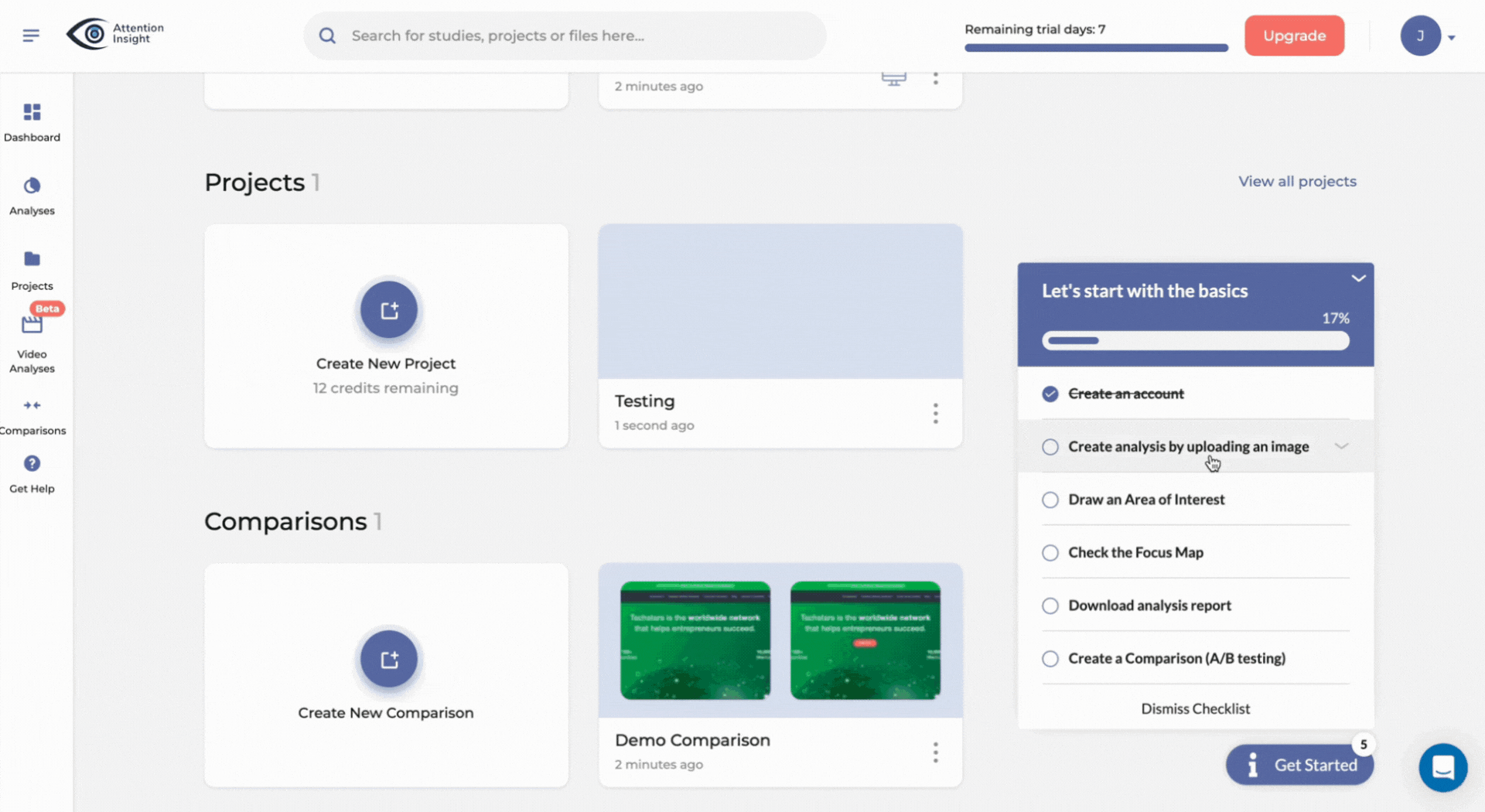
Guide customer experience with an onboarding checklist
Checklists break the initial setup steps into small, manageable tasks that make your onboarding process feel less daunting. Just seeing the number of steps ahead and ticking each one off gives users a psychological boost that creates a sense of progress and motivation to complete tasks.
Userpilot makes it easy to create and launch onboarding checklists. Without writing a line of code, the drag-and-drop builder lets you define tasks and specify their completion actions. You can even customize the widget and beacon to perfectly match your brand’s style.
That’s exactly what Sked Social did to improve product adoption. Using Userpilot, the company built an onboarding checklist with a progress bar that visually tracks how close each user is to completing setup. This made it easy for users to follow the onboarding process and stay motivated.
Sked Social saw 3X higher conversions among users who completed their checklist. Why? Because following through to the end helped users fully understand the product and experience its value firsthand.
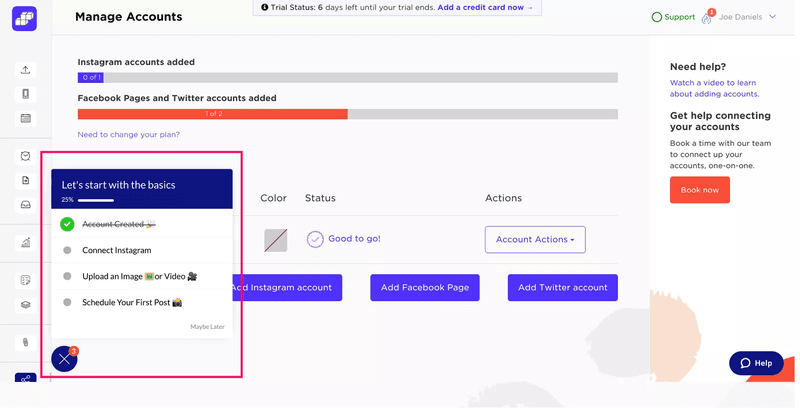
Reduce TTV with an AI agent
The faster users experience your product’s core, undeniable benefit, the exponentially more likely they are to stick around, become loyal, and advocate for your brand.
This is why my primary goal in the activation phase is to minimize the time to value (TTV). This isn’t just about speed; it means strategically stripping away any unnecessary steps in the onboarding process, rigorously clarifying the most direct path to the “Aha! Moment,” and ensuring every interaction serves to propel the user forward.
Userpilot’s Product Growth Agent comes in handy here. It works alongside your team to continuously shorten the path from signup to success by:
- Detecting friction automatically: The AI Agent can analyze behavioral data, surveys, and session replays to pinpoint where new users drop off or get stuck during onboarding.
- Recommending the fastest fixes: Instead of just flagging an issue, the Agent can suggest or even build the ideal in-app flow in real time to guide users back toward value.
- Personalizing the journey in real time: The Agent can adjust onboarding content based on a user’s segment, activity level, and goals, ensuring every user sees the most relevant experience at the right time.
- Monitoring outcomes continuously: It can track the results of your newly deployed flows, reinforce what works best, and refine what doesn’t, all without waiting for a manual review cycle.
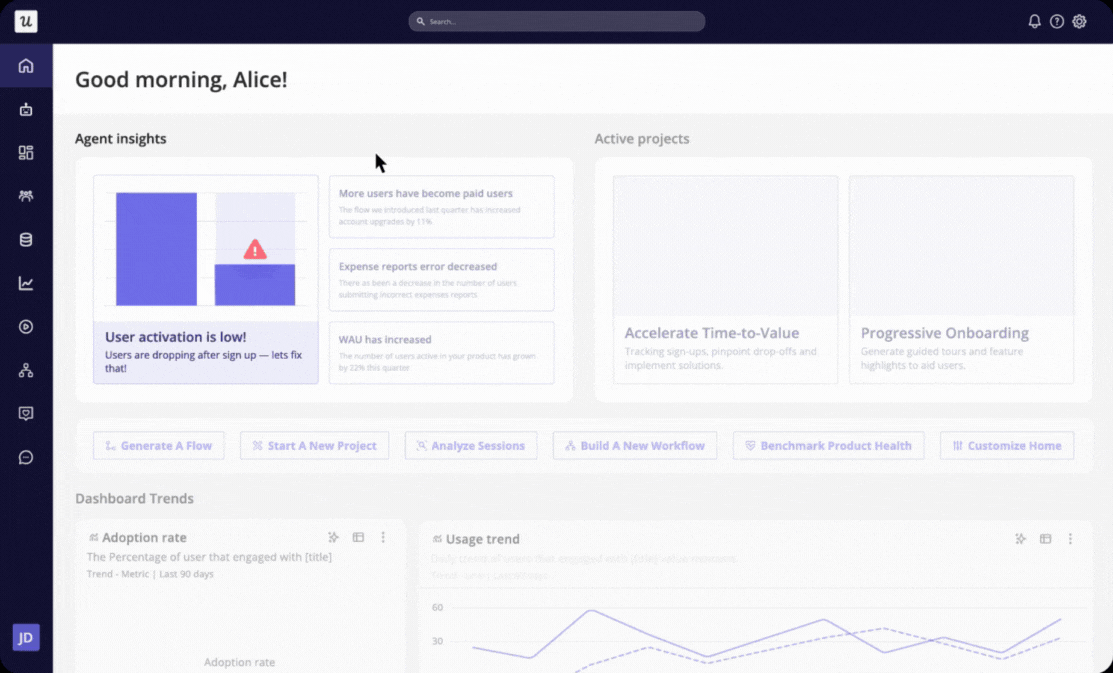
User engagement strategies to retain users
After successful activation, the next challenge is keeping users engaged and coming back regularly. This stage is critical in SaaS, where the average CAC payback period ranges from 10 to 24 months. Losing users before that point means losing money.
The following strategies will help you strengthen customer relationships, deliver continuous value, and turn occasional users into loyal, long-term customers.
Deliver contextual in-app messaging to improve customer satisfaction
As users continue exploring your product, they’ll often encounter moments where a quick, well-timed message can reduce friction and help them complete a task faster.
You can do this with tooltips that explain new icons, modals that highlight new features, or banners that guide users back to unfinished setup tasks.
Here’s how Talana, a Latin American HR and payroll platform, used tooltips to provide contextual help:
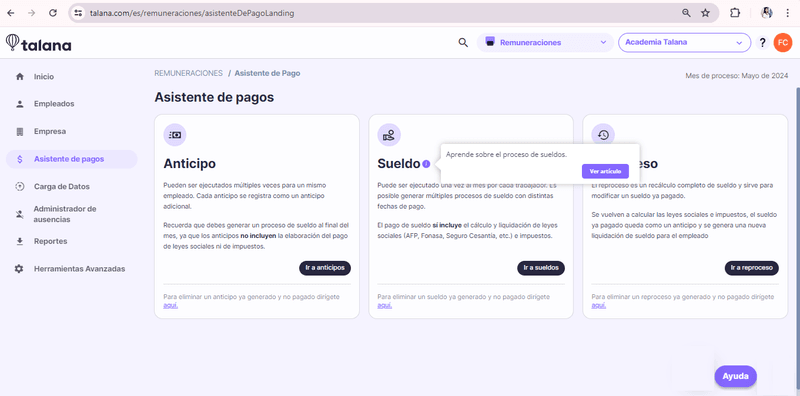
Userpilot lets you easily create and trigger these in-app messages exactly when users need them.
With the upcoming Product Growth AI Agent, this process will become even more proactive. You can run the Agent in copilot or autonomous modes, where it detects friction points and immediately triggers UI patterns with messages tailored to each user’s context.
Collect and act on user feedback to boost customer engagement
To retain users and evolve your product, you need to understand what they think and feel at every stage of their journey. I find in-app feedback surveys to be one of the most effective ways to do this because they capture valuable insights right when users are active and engaged.
A quick Net Promoter Score (NPS) survey after a key workflow, or a short Customer Effort Score (CES) questionnaire following a feature update, often yields more relevant feedback than waiting days or weeks later to vaguely ask users what they think about your product.
Userpilot lets you create in-app surveys code-free. You can choose from our template library or build your own from scratch, with full customization flexibility.

But building and triggering surveys is only half the battle. What truly drives retention is analyzing responses and acting on recurring pain points. I know firsthand how exhausting this can be to do manually. You often end up spending hours comparing customer satisfaction scores with qualitative responses just to uncover a few patterns.
That’s where Userpilot’s Product Growth AI Agent comes in. It can analyze survey data, cluster feedback themes, and automatically surface actionable insights. This means you spend less time sorting through data and more time improving your product based on what customers actually need.
Deliver self-service support with a resource center
Have you ever used a SaaS product, gotten stuck, and found yourself searching for help that just wasn’t there? No tooltip, no quick guide, nothing. You end up leaving the app, opening their help docs in a new tab, and scrolling for minutes just to find a simple answer.
Frustrating?
That’s exactly what your customers experience when your product lacks an in-app resource center. Small moments like this may not seem serious, but they slowly erode satisfaction and can eventually lead to churn.
With Userpilot, you can easily create a resource center and connect it to your existing knowledge base, whether it’s Zendesk, HubSpot, or another platform. This way, users can find answers without ever leaving your product.
Beyond help articles, you can enrich your resource center with FAQs, tutorial videos, product updates, or even a quick link to reach a human support agent when needed.

That’s what Cleeng did after noticing a 92% drop in feature usage following a UI update. Using Userpilot, the team implemented page analytics to uncover the core issue. Then, built in-app guides to direct users and a resource center that provides on-demand support when needed.
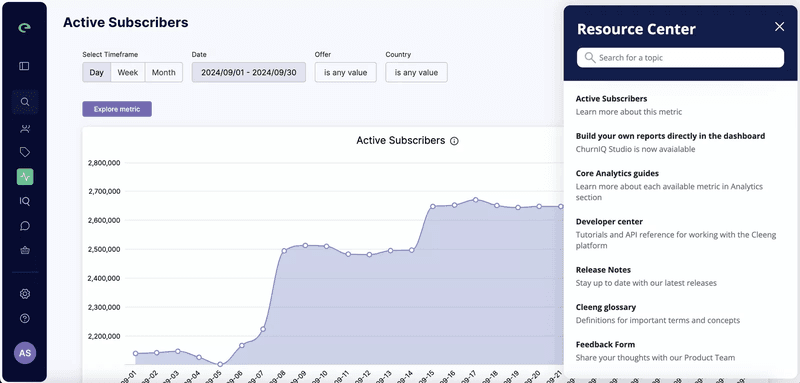
“Userpilot’s resource center is a game-changer. With [our] old navigation, the help center button was sending users outside of the app, which we didn’t really want. Now, when they click the button, they can see the Userpilot Resource Center.” – Anna Sobiak, Product Designer.
Pro tip: Anticipate customer needs and address potential issues before they even arise. This could mean a small, non-intrusive in-app message flagging a known problem or a personalized email offering help after a period of unusually low activity.
User engagement strategies to drive expansion
Once you’ve activated and retained your users, the next step is to turn that satisfaction into growth. This stage is all about helping existing customers get even more value from your product through deeper feature adoption, account upgrades, and advocacy that attracts new users.
Drive feature adoption for engaging customers
Even your most loyal users may not be fully utilizing your product’s capabilities. Use a tool like Userpilot to analyze product usage data and spot such customers. For example, you could create a segment of users who have been active for at least six months but rarely interact with a key functionality.
Once you identify this group, use the in-app guidance formats we discussed earlier to communicate the value of those features and show users how to maximize their use.
The same principle applies when releasing new features. Don’t assume users will naturally discover them just because they log in often. Instead, use modals, hotspots, or even a small “New!” tag to highlight what’s new and why it matters.
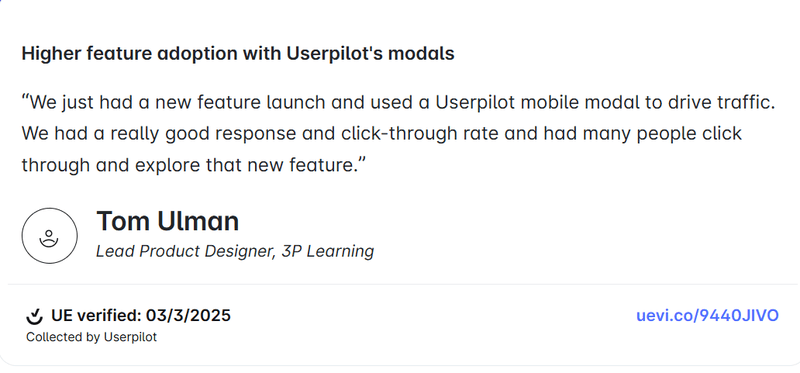
Upsell engaged users to meet their needs
I’ve seen the Pareto principle play out time and again in SaaS: most of a company’s revenue comes from a small group of loyal, recurring customers.
McKinsey senior partner Harald Fanderl captured it well:
“To make up for the loss of one existing customer, companies have to acquire three new ones. And 80 percent of the value creation achieved by successful growth companies comes from their core business—namely, generating new revenue from existing customers.”
Spotting upsell opportunities doesn’t have to be complicated. Here’s a simple, three-step workflow I often use:
- Identify upgrade signals: Use Userpilot to automatically detect when users hit a usage limit, explore premium features, or show signs of growing product maturity.
- Trigger contextual nudges: Deliver a timely, in-app message that highlights how upgrading can help them achieve their goals. Keep it helpful, not pushy.
- Re-engage users: Follow up via email or mobile push for users who started but didn’t finish an upgrade process.

Reward loyal customers
Rewarding users for their continued engagement is one of the most effective ways to strengthen loyalty and deepen product adoption. But it only works when done with intention.
Points, badges, and leaderboards might drive short-term excitement in B2C apps, but they rarely create lasting impact in B2B SaaS. The key is to offer rewards that genuinely add value at each stage of the user journey and encourage further exploration of your product.
For example, you could:
- Offer a trial extension to users who complete their onboarding flow.
- Provide exclusive training sessions or early feature access for long-time power users who consistently engage with your product.
- Give temporary access to premium features for customers on lower-tier plans who achieve specific milestones.

Encourage advocacy among engaged users
Transforming satisfied customers into vocal champions for your brand is an incredibly powerful and cost-effective strategy for organic growth. Their authentic recommendations carry immense weight and credibility, boosting trust and attracting new users in a way that traditional marketing alone simply cannot achieve.
Research supports this clearly: for example, a study by the Nielsen group found that 88% of customers trust recommendations from people they know more than any other channel.
So, how do you encourage user advocacy?
Begin by identifying your power users. These are people who are consistently engaged, highly active, and enthusiastic about your product.
Segment them and trigger in-app messages or emails inviting them to leave reviews on platforms like G2 or Capterra. You can offer small rewards, such as extra credits or gift cards, to encourage participation.
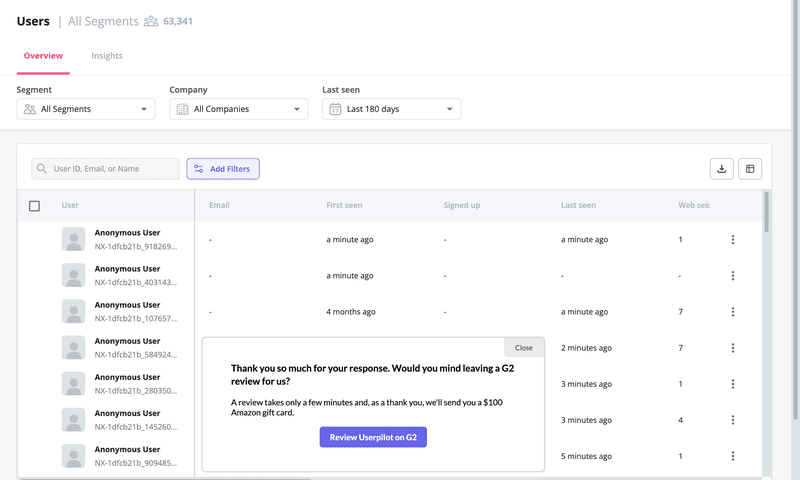
If you have the bandwidth, you can take advocacy a step further by creating moments worth sharing. For example:
- Canva celebrates user milestones by sending design certificates when users reach milestones like 10, 50, or 100 designs, encouraging them to share their achievements on social media.
- Notion partnered with influencers like Snoop Dogg to promote its #NotionFaces avatar campaign, turning customization into community buzz.
How to measure and optimize your user engagement strategy
None of these strategies works in isolation, and they’re never “set and forget.” To truly succeed, you need to measure impact across the entire customer journey, learn from the data, and refine your approach as your users and product evolve.
In this section, I’ll break down the key engagement metrics to track and the tools that can help you analyze, optimize, and grow.
Key customer engagement metrics to track
There are countless ways to measure engagement, but I always focus on five core metrics. Together, they give a balanced view of both customer and product health.
- User engagement score: This composite metric captures how actively users interact with your product over time. It blends frequency, depth, and breadth of activity to show how engaged users truly are.
- Monthly active users (MAU): A foundational metric that tracks the number of users who interact with your product within a given month. It’s often analyzed alongside daily active users (DAU) to measure consistency and depth of engagement over time.
- Churn and retention rate: These twin metrics reveal how many users you’re keeping versus losing over time. They’re the clearest indicators of product stickiness and customer satisfaction.
- Customer lifetime value (CLV): A financial measure that estimates the total revenue an average customer generates throughout their relationship with your company. It connects engagement directly to long-term business growth.
- Customer satisfaction and Net Promoter Score (NPS): These provide direct, quantifiable customer feedback to help you gauge satisfaction and loyalty.
You can track all these metrics directly in Userpilot’s dashboards and analyze them easily with the Product Growth Agent:
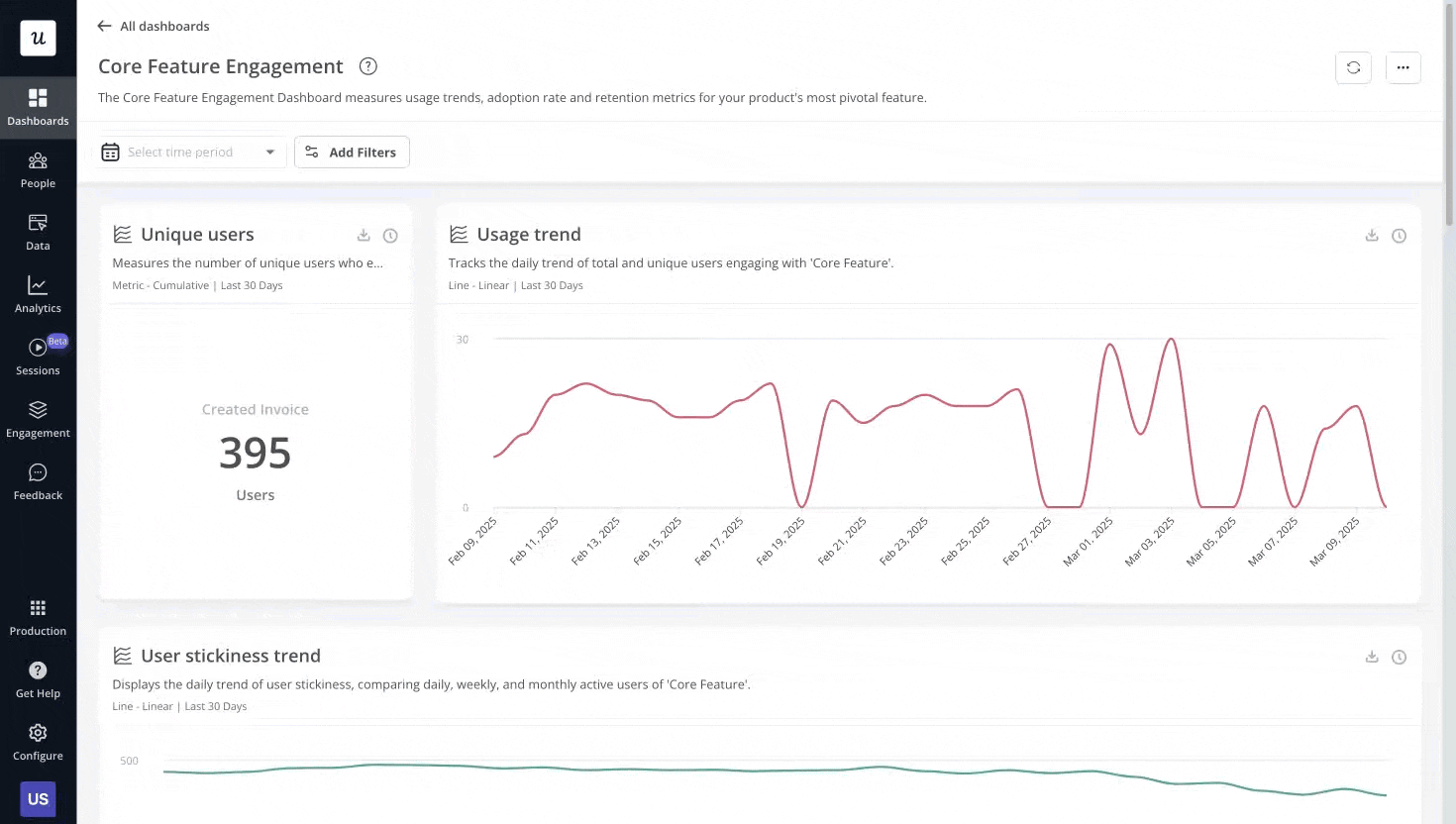
Key tools to track and improve user engagement
The right tools help you measure engagement accurately and act on your insights in real time. Here are some of the ones we use at Userpilot:
- Funnels and paths: These help you visualize the customer journey and see exactly where users get stuck or drop off. Userpilot lets you build custom funnels and path reports for different parts of the experience. For example, after rolling out a new feature, you can create a funnel report to track interactions from the feature announcement to the first use, and see what percentage of users dropped off along the way.
- Session replay: Numbers tell you what’s happening, but session replays show you why. Watching real users interact with your product helps uncover friction points, confusing UI patterns, or unexpected user behaviors that metrics alone can’t reveal.
- Custom dashboards: Every product has unique goals, so your analytics should reflect that. Userpilot’s customizable dashboards let you pull together everything that matters most in one place. You can share dashboards across teams to align insights and drive faster, more informed decisions.
- A/B testing: Improving engagement means constant experimentation. I regularly test variations of onboarding flows, in-app messages, and feature announcements to see what resonates most with each user segment. You can also do this code-free with Userpilot.
- AI analytics: Data-driven companies consistently outperform their peers, and AI is amplifying that advantage. With tools like Userpilot’s Growth Agent, you can automatically analyze behavior patterns and customer feedback to uncover insights that might otherwise go unnoticed.
Build and monitor your user engagement strategy with Userpilot
Userpilot is a leading product growth platform that helps product, customer success, and growth teams build personalized, behavior-driven experiences code-free. Here’s how it supports each stage of your engagement strategy:
- No-code building: Create engaging in-app experiences like walkthroughs, checklists, banners, and even mobile content using an intuitive visual builder.
- Deep segmentation: Target specific user segments based on properties like role, plan, or behavior. These advanced segmentation capabilities help you deliver hyper-personalized experiences that truly resonate.
- Behavioral triggers: Whether it’s a tooltip during onboarding or a modal after a milestone, Userpilot helps you deliver contextual messages exactly when users need them.
- Rich analytics: From autocaptured events and session replays to feature usage analytics and retention reports, Userpilot gives you a complete view of what’s working, what isn’t, and where to optimize next to improve the entire user experience.
- AI-powered insights: As mentioned earlier, the Product Growth AI Agent can automatically measure user engagement, uncover upsell opportunities, and even generate in-app messages or surveys. It’s like having a growth analyst on your team working 24/7 to make engagement smarter and faster.
- Cross-channel reach: Userpilot supports multichannel messaging from one control center. You can easily send in-app notifications, email reminders, or mobile push notifications to specific user groups, helping them actively engage with your product through timely, relevant communication.
- Seamless integrations: You can connect Userpilot with tools like HubSpot, Salesforce, Amplitude, and Mixpanel to unify your customer data and create a single source of truth across teams.
- Robust data sync: For deeper analysis, Userpilot Data Sync exports raw event data directly into your infrastructure, giving you complete data ownership and flexibility for advanced reporting and BI integration.
Ready to see it in action? Book a demo to discuss your needs.
FAQ
What’s the difference between user engagement and customer engagement?
User engagement focuses on how people interact with your product. It measures the frequency, depth, and quality of their actions within it.
Customer engagement, on the other hand, is broader. It includes all touchpoints, from emails and support conversations to community participation and social media interactions. In other words, user engagement happens in the product, while customer engagement happens around the product.
What are the 4 Ps of customer engagement?
The 4 Ps are personalization, proactivity, predictiveness, and purpose.
- Personalization ensures interactions and experiences feel tailored to each user.
- Proactivity means anticipating user needs and addressing them before issues arise.
- Predictiveness involves using data and AI to forecast customer behavior and guide them accordingly.
- Purpose focuses on building authentic, value-driven relationships rather than transactional ones.
What are examples of engagement strategies?
Common customer engagement strategies include:
- Using interactive onboarding walkthroughs to guide new users through key workflows.
- Delivering contextual in-app messages to reduce friction.
- Creating self-service resource centers and in-app support to empower users.
- Running in-app surveys to collect valuable feedback and act on insights.
- Rewarding loyal users or inviting them to participate in referral and advocacy programs.
- Using AI-driven insights from tools like Userpilot’s Product Growth Agent to continuously optimize the user experience.

